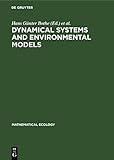Dynamical Systems and Environmental Models : Proceedings of an International Workshop cosponsored by IIASA and the Academy of Sciences of the GDR, held on the Wartburg, Eisenach (GDR), March 17—21, 1986 / hrsg. von Hans Günter Bothe, Manfred Peschel, Alexander B. Kurzhanski, Werner Ebeling.
Material type: TextSeries: Mathematical EcologyPublisher: Berlin ; Boston : De Gruyter, [2022]Copyright date: ©1987Edition: Reprint 2021Description: 1 online resource (284 p.)Content type:
TextSeries: Mathematical EcologyPublisher: Berlin ; Boston : De Gruyter, [2022]Copyright date: ©1987Edition: Reprint 2021Description: 1 online resource (284 p.)Content type: - 9783112484678
- 9783112484685
- online - DeGruyter
- Issued also in print.
| Item type | Current library | Call number | URL | Status | Notes | Barcode | |
|---|---|---|---|---|---|---|---|
 eBook
eBook
|
Biblioteca "Angelicum" Pont. Univ. S.Tommaso d'Aquino Nuvola online | online - DeGruyter (Browse shelf(Opens below)) | Online access | Not for loan (Accesso limitato) | Accesso per gli utenti autorizzati / Access for authorized users | (dgr)9783112484685 |
Frontmatter -- Introductory Remarks -- List of Participants -- Contents -- Part I: Mathematical Theory of Dynamical Systems -- Hausdorff dimension of attractors: An example -- K-stability as an ecologically more relevant stability concept -- Stability, periodicity and chaos from the statistical point of view -- Singularly perturbed autonomous differential systems -- Difference equations with continuous time as mathematical models of the structure emergencies -- Stability of equilibria in critical cases -- Part II: General Mathematical Models -- Permanence in population dynamics -- Models of evolution processes including age structure -- Pattern formation in an ionic reaction-diffusion system: A contribution to the morphogene prepattern theory of mitosis -- Chaotic dynamics and fluctuations in a biochemical system -- Periodic, quasiperiodic and chaotic motion in a forced predator-prey ecosystem -- Chaotic dynamics of logical paradoxes -- Control of growth processes -- Part III. Mathematical Models for Concrete Processes -- The Belousov-Zhabotinskii Reaction : A paradigm for theoretical studies of dynamical systems -- The nitrogen transformation cycle in water -- Modelling of polymer growth -- A mathematical model of group defence in predator-prey systems -- Vector-transmitted diseases in structured populations -- Nonlinear behaviour in mathematical models of anaerobic digesters -- Examples of computer-aided exploration and design of dynamical systems in neurosciences: Design of optimal nets -- A dynamical model of synaptic transmission -- Gradients for replicator systems -- Part IV: Mathematical Description of Environmental Processes -- The limiting factor concept in relation to stability, sensitivity and bifurcation in plankton models -- Effects of structured environment to dynamic, behaviour : Some illustrations -- Modelling and control of yeast growth in biotechnical systems -- A dynamic simulation model of tree development under pollution stress -- A biota model to assess the influence of human impacts on the global carbon cycle -- An integrative approach to the solution of ecological problems with particular attention to the regional case -- Application of the evolon model on evolution and energy growth processes -- Non-linear dynamics of the epidemics of some childhood deseases in Copenhagen, Denmark -- Modelling an estimating transport and fate of heavy metals in water column and sediment layer in some enclosed branches of the sea in the S.W. Netherlands -- POSTER SESSION -- Mathematical software developed by the Karl-Weierstraß-Institute of Mathematics
restricted access online access with authorization star
http://purl.org/coar/access_right/c_16ec
Issued also in print.
Mode of access: Internet via World Wide Web.
In German.
Description based on online resource; title from PDF title page (publisher's Web site, viewed 01. Dez 2022)


